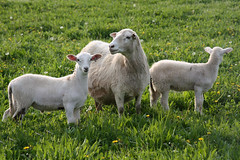 Katahdin ewe with twin lambs
Katahdin ewe with twin lambs
 Smut-faced lamb
Smut-faced lamb

Katahdin ewe and lamb |
Sheep Senses
Because they are a prey animal, sheep require excellent senses
to enhance their chances of survival in the wild.
Vision
Sheep depend heavily on their vision. They have excellent peripheral
vision and can see behind themselves without turning their heads.
However, they have poor depth perception. They cannot see immediately
in front of their noses. Some vertical vision may also have been
sacrificed in order to have a wider field of vision. For example,
it is doubtful that a sheep would be able to see something in
a tree.
Color perception
Contrary to previous thought, sheep and other livestock perceive
colors, though their color vision is not as well-developed as
it is in humans. Sheep will react with fear to new colors.
Hearing
Sheep have excellent hearing. They can direct their ears in the
direction of a sound. Sound arrives at each ear at slightly different
times, with a small difference in amplitude. Sheep are frightened
by high-pitched and loud noises, such as barking dogs or firecrackers.
Smell
Sheep have an excellent sense of smell. They are very sensitive
to what different predators smell like. Smell helps rams locate
ewes in heat and ewes locate their lambs. Sheep also use their
sense of smell to locate water and determine subtle or major differences
between feeds and pasture.
Taste
The sense of taste in sheep is probably not as important as the
other senses. However, sheep have the ability to differentiate
different feedstuffs and taste may play a role in this ability.
When presented with a variety of feeds, sheep will select certain
feeds over others. Sheep will select different types and species
of plants than other livestock.
Touch
Since the sheep's body is covered with wool or coarse hair, only
the nose, lips, mouth, and maybe ears readily lend themselves
to touching behavior. However, touching is important to the interaction
between sheep. Lambs seek bodily contact with their mothers and
the ewes respond to touching in many ways, including milk letdown
in response to the nuzzling/suckling stimulus of lambs. When young
lambs sleep, they will seek out their mothers and lie close to
them.
Learn how sheep's natural instincts
protect them from predators=>
<== ABOUT SHEEP
|